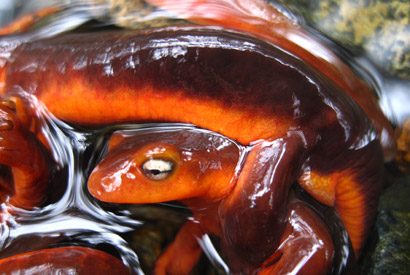Newts, up close and (very) personal
For a front-row view of a biological spectacle, newt love, there’s no better spectator stand than the banks of the UC Botanical Garden’s Japanese Pool, and no better time than now. Docents are on hand at specified times to explain the life-cycle and mating rituals of these lively and fascinating amphibians.

February 11, 2013
Birds, bees and educated fleas do it. And don’t forget the newts.
For a front-row view of a biological spectacle, newt love, there’s no better spectator stand than the banks of the UC Botanical Garden’s Japanese Pool, and no better time than now.
Two newt species – Taricha torosa (California newt) and Taricha granulosa (rough-skin newt) – dwell in the garden. For most of the year, these small, dark-skinned amphibians hide in the underbrush and are rarely seen by humans.
Come the rains, though, scores of Tarichas find their way to the crystal-clear waters of the Japanese Pool. “Once you start looking in the pond, they’re everywhere,” one recent visitor reports.
Soon, the males undergo enormous physical changes, says garden director Paul Licht, a zoologist who began studying these creatures decades ago. Their skin gets smooth and shiny, the muscles in their front legs bulk up – all to better climb onto and arouse a female, then deposit their sperm in the pool. From there the females take over, gathering up the sperm and laying fertilized eggs (singly or as gelatinous sacs of multiple eggs, depending on the species), which hatch as four-legged babies.
You may be surprised to learn that these newts live up to 20 years. The secret to their longevity? “They’re one of the most toxic animals in the world,” says Licht; a powerful secretion from their skins protects them from predators. Making “eye of newt” a potent ingredient for a witches’ brew?
To witness the newts having tons of fun, visit the Japanese Pool during garden hours.
Docents will be on hand – to explain the newts’ mating habits, lifecycle and habitat – from 2 to 3:30 p.m., Sunday, Feb. 17, and Monday, Feb. 18. (This is free with garden admission.)
For photos and a podcast on the garden newts, see the garden’s fauna website.